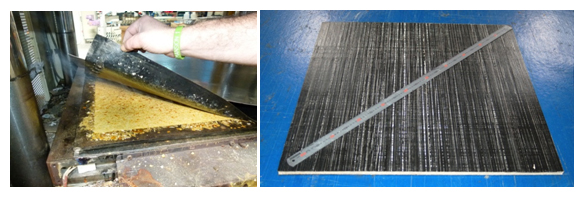Mechanical recycling for recovering concentrates of inorganic fibers and other materials from end-of-life rotor blades comprises several operations (optimised in BRIO project): pre-crushing, coarse shredding, grinding and separation stages by means of a combination of different technologies (magnetic systems, screens or automatic sensor-based sorting lines). From previous actions it is known that two types of recycled products are obtained after the mechanical process:
- Fiber material: composed by groups of fibers covered by resin with an aspect ratio higher than 1:20. This material can be used as short reinforcing fiber in organic composites and cement based materials.
- Heterogeneous material (ground mixture): pieces of composite with a low aspect ratio composed by composite fragments, fillers and foams with laminar or granular shape.
Two rotor blades supplied by ScottishPower Renewables (12.6m long, made of glass fiber reinforced plastic (GFRP) were used for research and demonstration purposes. Once the fiber material was obtained, it was characterized (View newsletter 2) and sent to precast concrete manufacturers to be used in their products. The amount of fibers (dosage) was based on preliminary lab trials. Three types of demonstrative precast concrete elements were considered to include recovered materials from blades recycling: precast manholes (elements to allow access to the wastewater networks for maintenance and for aeration and ventilation), New Jersey barriers (safety concrete elements used to delimit different areas of transit and prevent vehicles accidentally leaving the lane they are driving in) and “Lego®” type blocks (to form walls without chemical joints).
Manhole prototypes were manufactured and tested until failure, getting an improved (+12%) resistance to crushing. After visual inspection and verification of no changes in quality, BRIO New Jersey barriers were installed in a public road in Lumbreras (La Rioja, Spain). Concrete block prototype are being used for retaining and separation walls. The functionality of the elements has been increased in all cases and the manufacturers are considering additional market applications.

The secondary raw material obtained as a by-product along the stages of the recycling process of rotor blades was used in the manufacture of the cores for sandwich panels. The prototypes panels consisted of an internal core made of powdered resin and ground heterogeneous mixture from rotor blades mechanical treatment and two outer layers of glass fiber reinforced composite (virgin or first usage). The experimental manufacturing process of the prototypes according to the defined formulations comprised two main phases:
- Obtaining the recycled material-based cores by compression molding in a press
- Joining cores and outer peels together by means of compression or laminating techniques depending on the nature of the peels.
In addition, the technical performance of two developed formulations of multilayer panels has been characterized. It has been concluded that said technical performance is closely related to the type of outer peels. The prototypes manufactured in the project do not have thermal or acoustic insulation capacities but they have mechanical properties similar to commercial products (certain plywood panels).

